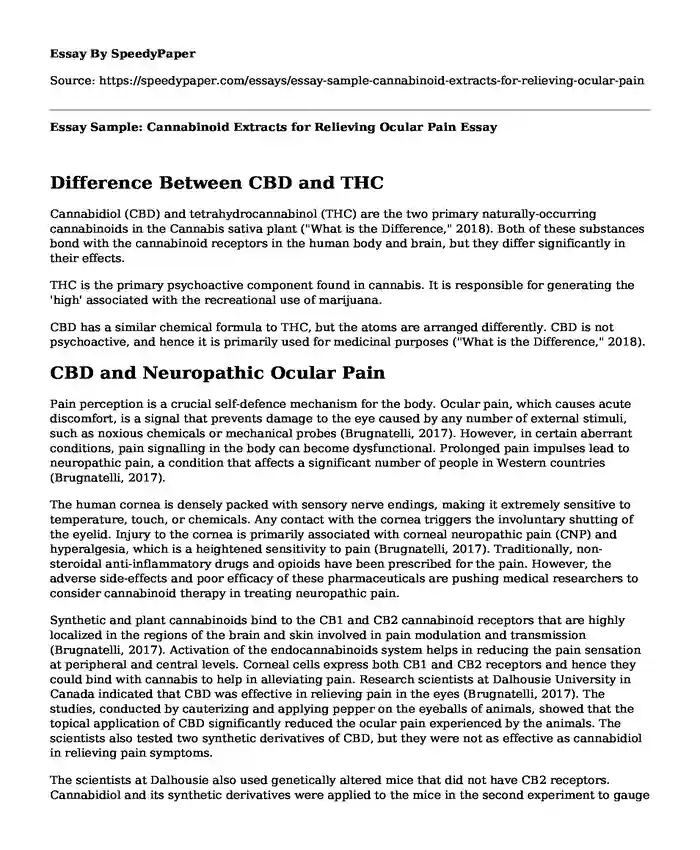
| Type of paper: | Essay |
| Categories: | Pharmacology |
| Pages: | 3 |
| Wordcount: | 625 words |
Difference Between CBD and THC
Cannabidiol (CBD) and tetrahydrocannabinol (THC) are the two primary naturally-occurring cannabinoids in the Cannabis sativa plant ("What is the Difference," 2018). Both of these substances bond with the cannabinoid receptors in the human body and brain, but they differ significantly in their effects.
THC is the primary psychoactive component found in cannabis. It is responsible for generating the 'high' associated with the recreational use of marijuana.
CBD has a similar chemical formula to THC, but the atoms are arranged differently. CBD is not psychoactive, and hence it is primarily used for medicinal purposes ("What is the Difference," 2018).
CBD and Neuropathic Ocular Pain
Pain perception is a crucial self-defence mechanism for the body. Ocular pain, which causes acute discomfort, is a signal that prevents damage to the eye caused by any number of external stimuli, such as noxious chemicals or mechanical probes (Brugnatelli, 2017). However, in certain aberrant conditions, pain signalling in the body can become dysfunctional. Prolonged pain impulses lead to neuropathic pain, a condition that affects a significant number of people in Western countries (Brugnatelli, 2017).
The human cornea is densely packed with sensory nerve endings, making it extremely sensitive to temperature, touch, or chemicals. Any contact with the cornea triggers the involuntary shutting of the eyelid. Injury to the cornea is primarily associated with corneal neuropathic pain (CNP) and hyperalgesia, which is a heightened sensitivity to pain (Brugnatelli, 2017). Traditionally, non-steroidal anti-inflammatory drugs and opioids have been prescribed for the pain. However, the adverse side-effects and poor efficacy of these pharmaceuticals are pushing medical researchers to consider cannabinoid therapy in treating neuropathic pain.
Synthetic and plant cannabinoids bind to the CB1 and CB2 cannabinoid receptors that are highly localized in the regions of the brain and skin involved in pain modulation and transmission (Brugnatelli, 2017). Activation of the endocannabinoids system helps in reducing the pain sensation at peripheral and central levels. Corneal cells express both CB1 and CB2 receptors and hence they could bind with cannabis to help in alleviating pain. Research scientists at Dalhousie University in Canada indicated that CBD was effective in relieving pain in the eyes (Brugnatelli, 2017). The studies, conducted by cauterizing and applying pepper on the eyeballs of animals, showed that the topical application of CBD significantly reduced the ocular pain experienced by the animals. The scientists also tested two synthetic derivatives of CBD, but they were not as effective as cannabidiol in relieving pain symptoms.
The scientists at Dalhousie also used genetically altered mice that did not have CB2 receptors. Cannabidiol and its synthetic derivatives were applied to the mice in the second experiment to gauge the effect on corneal pain. The CBD had an analgesic effect on the mice's eyes, but the painkilling effect was considerably diminished. The synthetic derivatives did not help with pain alleviation at all. The scientists concluded that CBD fights corneal pain by binding with CB2 receptors.
Application
The use of cannabinoid extracts for topical application in relieving ocular pain is well-established, but their lipophilic profile makes them challenging to apply to their water insolvency. Oil and water do not mix, and hence CBD eye-drops could be ineffective since the oil cannot go past the watery layer that covers the cornea (Brugnatelli, 2017). Since the 1970s, people have smoked THC-rich marijuana to relieve symptoms of glaucoma and lower intra-ocular pressure, but the effectiveness of CBD is hampered by the insoluble lipid. Cannabidiol has a high efficacy rate and minimal side effects, and hence researchers should find the most efficient way of delivering this cure to glaucoma, and other eye, patients
References
Brugnatelli, V. (2017). CBD Eye Drops: New frontier for ocular pain. Retrieved from https://www.projectcbd.org/cbd-eye-drops-ocular-pain
What is the Difference Between THC and CBD?. (2018). Retrieved from https://cbdoilreview.org/cbd-cannabidiol/thc-cbd/
Cite this page
Essay Sample: Cannabinoid Extracts for Relieving Ocular Pain. (2022, Oct 20). Retrieved from https://speedypaper.net/essays/essay-sample-cannabinoid-extracts-for-relieving-ocular-pain
Request Removal
If you are the original author of this essay and no longer wish to have it published on the SpeedyPaper website, please click below to request its removal:
- Free Essay: Change of Characters in the Story Bartleby the Scrivener by Herman Melville
- Essay Sample on Child Development: Learning Space for 3 to 4 Years Preschoolers
- Behavioral Change Theories on Smoking, Free Essay Sample for You
- Essay Sample: Michael Jackson Addiction to Demerol and Narcotics
- Free Essay Sample: Narrative and Poe
- Essay Sample on An HR Podcast, "Covid-19"
- Essay Sample on Comparison Between Aerobic and Anaerobic Exercise
Popular categories




